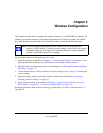
Wireless Cable Modem Gateway CG814WG v3 Reference Manual
Wireless Configuration 2-5
v1.0, June 2007
The settings in the Wireless Settings screen are explained in the following table.
Table 2-1. Wireless Settings
Settings Description
Wireless Network Name (SSID) The SSID is also known as the wireless network
name. Enter a 32-character (maximum) name in this
field. The characters are case sensitive.
In a setting where there is more than one wireless
network, different wireless network names provide a
means for separating the traffic. Any device you want
to participate in a wireless network must use the
SSID.
Region The location where the gateway is used.
Channel The wireless channel used by the gateway. The
default is channel 6.
You should not need to change the wireless channel
unless you experience interference (shown by lost
connections and/or slow data transfers). Should this
happen, you may need to experiment with different
channels to see which is the best.
Wireless Access
Point
Enable Wireless Access Point On by default, you can also turn off the wireless radio
to disable access through this device. This can be
helpful for configuration, network tuning, or
troubleshooting activities.
Allow Broadcast Name (SSID) On by default, the gateway broadcasts its SSID,
allowing wireless stations which have a “null” (blank)
SSID to adopt the correct SSID. The default SSID is
NETGEAR.
If you disable broadcast of the SSID, only devices
that have the correct SSID can connect. This nullifies
the wireless network “discovery” feature of some
products such as Windows XP, but the data is still
fully exposed to a determined snoop using
specialized test equipment like wireless sniffers. For
this reason NETGEAR recommends that you also
enable wireless security.
Wireless Card
Access List
Turn Access Control On Access control is disabled by default so that any
computer that is configured with the correct SSID
can connect. For information about access control,
see “Turning on Access Control to Restrict Access by
MAC Address” on page 2-6.


















